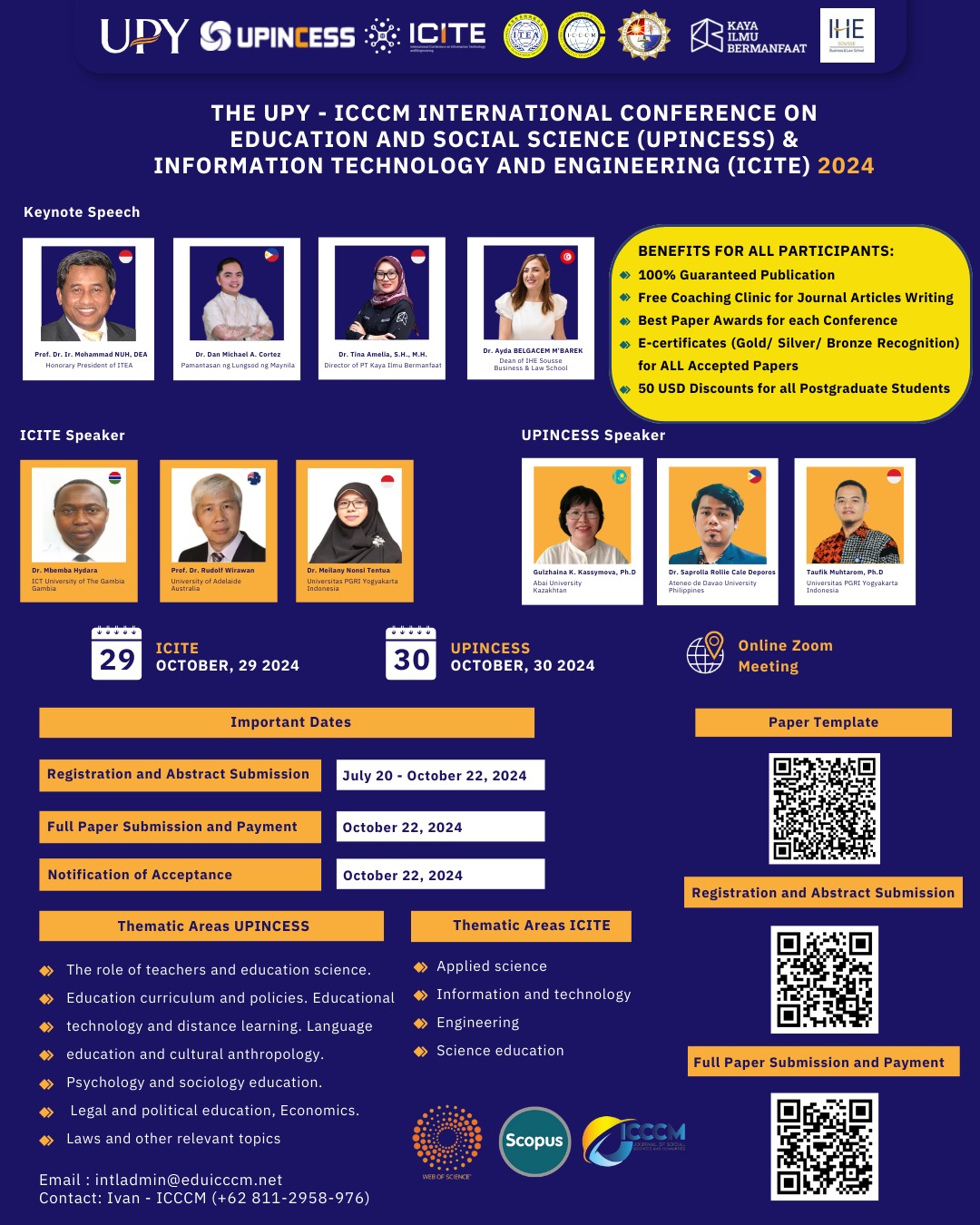Analysis of Illocutions and Perlocutions in the Declarations of Presidential and Vice-Presidential Candidates Prabowo and Gibran
DOI:
https://doi.org/10.53797/icccmjssh.v2i1.4.2023Keywords:
Locution, illocution, perlocution, presidential and vice-presidential candidates, speech actsAbstract
This research aims to analyze locution, illocutionary and perlocution in the declarations of presidential and vice-presidential candidates Prabowo and Gibran. Pronunciation refers to the literal meaning of an utterance, pronunciation reflects the intention behind the utterance, and pronunciation refers to the effect of the utterance on the recipient. In the context of presidential and vice-presidential candidates, these statements are an important means of conveying the vision, mission and programs promoted by the candidates. Speech acts include several forms, namely elocutionary, illocutionary and perlocutionary speech acts. Locutionary speech acts are speech acts that express something in the sense of "saying" or speech acts in the form of sentences that are meaningful and understandable. Illocutionary speech acts are speech acts that are usually identified with explicit statements. These illocutionary speech acts often involve giving permission, saying thank you, making offers, and making promises. Perlocutionary speech acts are speech acts that involve other people's words about other people's non-linguistic attitudes and behaviour. The researcher intends to examine the elocutionary, illocutionary and perlocutionary speech acts used in the declarations of presidential and vice-presidential candidates Prabowo and Gibran
Downloads
References
Adlini, M. N., Dinda, A. H., Yulinda, S., Chotimah, O., & Merliyana, S. J. (2022). Qualitative Research Methods of Library Studies. EDUMASPUL Education Journal, 6(1), 974-980.
Ardiansyah, M. (2017, November). General Election In Indonesia. In International Conference on Democracy, Accountability and Governance (ICODAG 2017) (pp. 66-70). Atlantis Press.
Assimakopoulos, S. (2020). Incitement to discriminatory hatred, illocution and perlocution. Pragmatics and Society, 11(2), 177-195.
Azis, S. (2018). Presidential threshold policy in Indonesian presidential election of 2019. Studia Humanitatis, (4), 10-10.
Bariguna, F. P., Sulaeman, A., & Darmawan, W. B. (2021). Electoral Behavior in The Electability of Presidential and Vice Presidential Candidates in The 2019 Elections. JIP (Jurnal Ilmu Pemerintahan): Kajian Ilmu Pemerintahan Dan Politik Daerah, 6(1), 13-22.
Chairani, M., Sofyan, D., & Hardiah, M. (2020). Illocutionary and perlocutionary acts on YouTube videos employed by Niana Guerrero. Journal of English Education and Teaching, 4(3), 413-430.
Grundlingh, L. (2018). Memes as speech acts. Social Semiotics, 28(2), 147-168.
Haucsa, G. M., Marzuki, A. G., Alek, A., & Hidayat, D. N. (2020). Illocutionary speech acts analysis in Tom Cruise's interview. Academic Journal Perspective: Education, Language, and Literature, 8(1), 11-19.
Hidayat, A. (2016). Speech acts: Force behind words. English Education: Jurnal Tadris Bahasa Inggris, 9(1), 1-12.
Izar, J., Nasution, M. M., Virginia, O.., & Harianto, N. (2022). The Analysis of Locutionary, Illocutionary, and Perlocutionary of Speech Acts in the Short Story "Rembulan dalam Cappuccino" by Seno Gumira Ajidarma. Journal of English Teaching and Linguistics, 3(1), 28-35. https://doi.org/10.55616/jetli.v3i1.265
Kissine, M. (2008). Locutionary, illocutionary, perlocutionary. Language and linguistics compass, 2(6), 1189-1202.
Khodijah, S. (2020). Illocutionary Act in Political Debate. Journal of Language Intelligence and Culture, 2(2), 141-158.
Lelet, I. T., Olii, S. T., & Kumayas, T. (2023). An Analysis Of Illocutionary Acts Performed By The Main Character In Divergent Movie By Neil Burer 2014 (Pragmatic Approach). JoTELL: Journal of Teaching English, Linguistics, and Literature, 2(5), 587-594.
Liu, J. (2020). A pragmatic analysis of hedges from the perspective of politeness principle. Theory and Practice in Language Studies, 10(12), 1614-1619.
Noble, H., & Heale, R. (2019). Triangulation in research, with examples. Evidence-based nursing, 22(3), 67-68.
Nugroho, R. M. (2022). Reconstruction of the mechanism of nomination for president and vice president in elections in indonesia. Borobudur Law Review, 4(2), 79-85.
Rahayu, F. N., Arifin, M. B., & Ariani, S. (2018). Illocutionary Act In The Main Characters’utterances In Mirror Mirror Movie. Ilmu Budaya: Jurnal Bahasa, Sastra, Seni dan Budaya, 2(2), 175-187.
Rosyidi, A. Z., Mahyuni, M., & Muhaimi, M. (2019). Illocutionary Speech acts use by jokowidodo in first Indonesia Presidential Election Debate 2019. International Journal of Multicultural and Multireligious Understanding, 6(2), 735-740.
Salsabila, D. R., & Suprijadi, D. (2021). The Analysis Of Locution, Illocution, And Perlocution Speech Acts In Mata Najwa Trans 7. PROJECT (Professional Journal of English Education), 4(6), 1030-1036.
Sholihatin, E. (2020). An analysis of illocutionary and perlocutionary speech act in defamation texts. Journal of Languages and Language Teaching, 7(1), 49-56.
Taufik, K. S., Tarjana, S., & Nurkamto, J. (2014). The persuasive utterances in a political discourse (the case study of the regent election campaign of Pasuruan, East Java-Indonesia). International Journal of Linguistics, 6(1), 192.
Downloads
Published
How to Cite
Issue
Section
License
Copyright (c) 2023 Ristiyani, Nur Alfin Hidayati, Siti Aliya Fatmawati, Putri Esa Agustina

This work is licensed under a Creative Commons Attribution-NonCommercial-ShareAlike 4.0 International License.




